Insulin is a hormone secreted by the β cells of the islets of Langerhans in the pancreas.
Insulin's primary function is to transport glucose into cells, which will be used for energy production. Thus, insulin is also essential for controlling the blood glucose level.
The insulin molecule is formed by 2 polypeptide chains, formed, respectively, by chains of 21 and 30 amino acids linked by disulfide bonds.
Modes of secretion and action

Insulin secretion begins with the recognition of glucose by the pancreatic β cell. Glucose is then transported into the cell by the glucose-carrying protein GLUT 2, where it is metabolized.
Increasing ATP/ADP Ratio Blocks K-Dependent Voltage Channels+, accumulating it and causing the membrane to depolarize, which increases the permeability to Ca ions2+, which will activate the secretory mechanism.
Secretion then takes place through the migration of the insulin-storing vesicles towards the membrane, followed by the extrusion of the granular contents.
To do its job, insulin needs to bind to its receptor on the cell membrane. There, it acts on metabolism and tissue growth, favoring protein production and glucose storage.
Insulin secreted in the blood circulates practically freely, with an average plasma half-life of about 6 minutes, being cleared from the circulation in 10 to 15 minutes.
With the exception of the portion that combines with receptors on target cells, all the rest of insulin is degraded by the enzyme insulinse, mainly in the liver.
Insulin and Diabetes Mellitus
Diabetes Mellitus is a disease caused by the partial or total loss of biological responses mediated by insulin.
The types of diabetes are:
- Type I diabetes: It usually appears in childhood or adolescence, being caused by an autoimmune destruction of the β cells of the islets of Langerhans. It is characterized by the absence or low levels of insulin in the blood, in addition to high levels of blood glucose, requiring the exogenous application of insulin;
- Type II diabetes: In most cases, it is associated with obesity and is caused by resistance to the action of insulin, mainly affecting adults.
Types
There are several types of insulin used to treat diabetes, they use the same principle of action as the insulin produced naturally by the body. Each type varies according to its mode of action, some have a quick effect, while others act more prolonged.
Types of insulin are classified into:
-
human insulin: This type of insulin is produced in the laboratory, using the recombinant DNA technique.
- regular human insulin: Has structure identical to human insulin and fast action.
- Human insulin NPH: When it is associated with protamine and zinc, having a longer-lasting effect than the regular one.
- Insulin analogues: They are the most modern, with shorter or longer-term action, and produced from human insulin.

